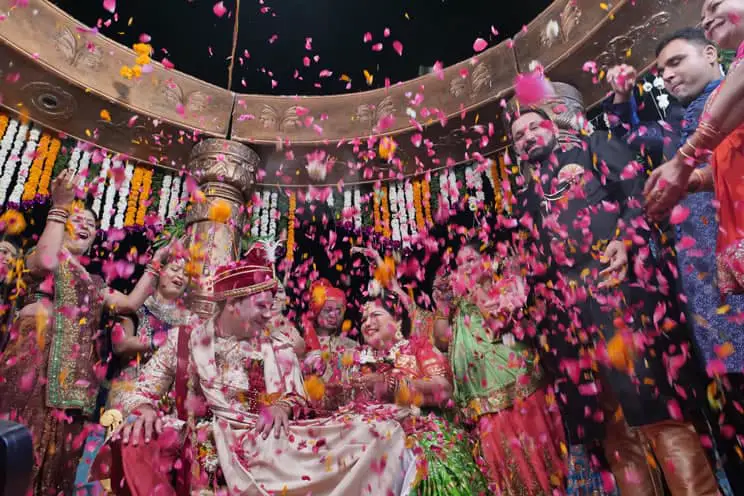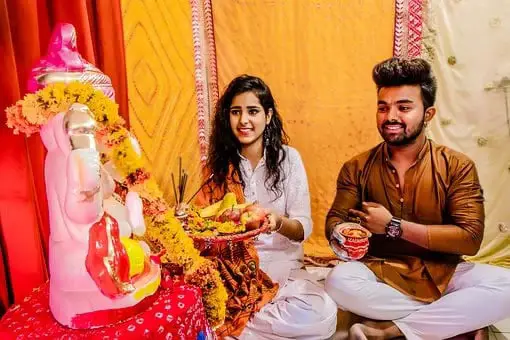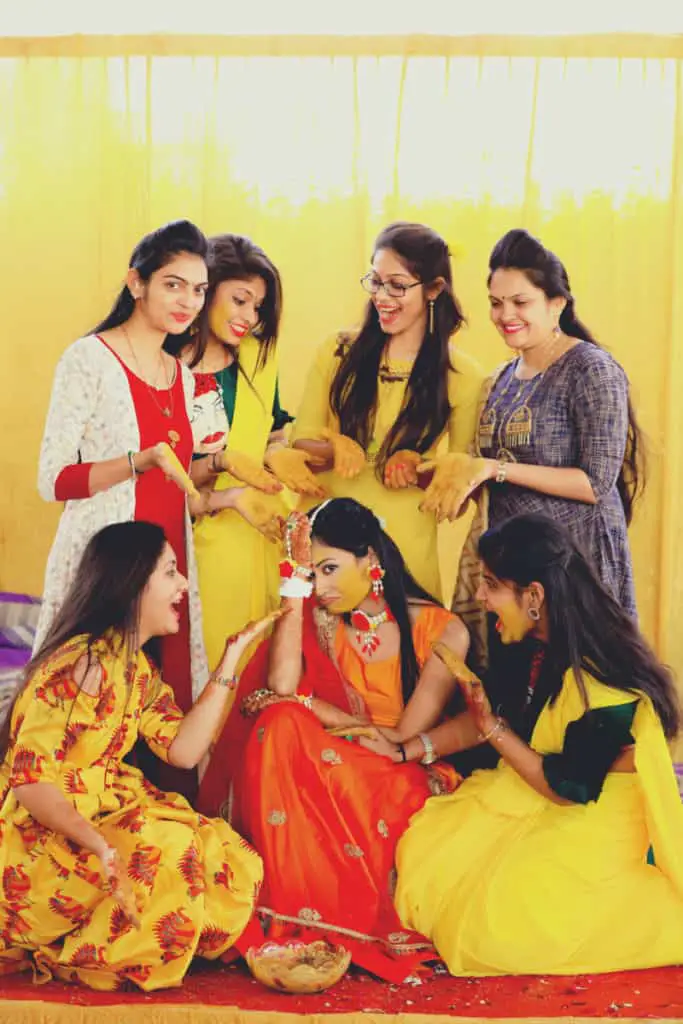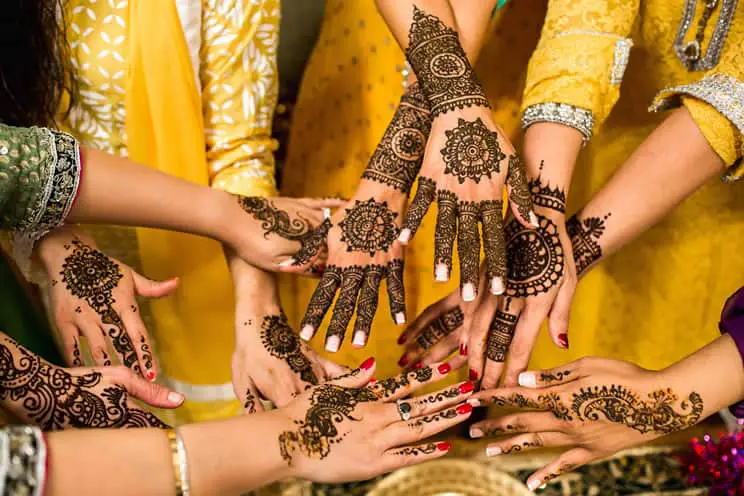
Hindu weddings are a multi-day event. According to Hindu beliefs, marriages are something made in heaven considering that bond is supposed to last for seven lifetimes. The Hindu society is one where the family is the basic unit, which is why the transfer of a family member to another household is a big deal.
Although many Hindu weddings can last up to 5 days, traditionally they only last up to 3 days. While most Western weddings typically last half a day, Hindu weddings tend to last longer due to the culture and spiritual background incorporated in these weddings.
Hindu weddings have numerous rituals that may take days to execute. We will dive further into the various Hindu wedding traditions throughout this article.
Deciding on the Date
Before the actual wedding is planned out, the couple will begin their planning by deciding on what date they want to have the wedding.
Traditionally, this decision is left up to the stars. According to Brides, using the couples date of births, a pandit (A Hindu priest) along with astrologists will “calculate the position of planets and stars to reflect the celestial union of the couple” and select the most auspicious time and date for the ceremony.
The First Day
Per Hindu tradition, all weddings must start with Ganesh Puja, which is a ceremony that invokes Lord Ganesh, the Elephant God of the Hindus. He brings good fortune and is regarded as a God that removes all kinds of obstacles, which is why all weddings start with this ceremony.

Hindu belief suggests that not having this ceremony could result in disastrous events for the couple and completely curse the marriage. Usually this ceremony will happen at home with close relatives, the bridal party and, of course, the couple.
This ceremony requires offerings made to an idol of Lord Ganesh, which is placed on a raised platform made out of any material. These offerings are:
- 21 Modaks, which are Ganesh Ji`s favorite sweet
- Coconut, which signifies shattering one`s ego when broken and is used for the blessings of Lord Shiva, Ganesh Ji`s father
- Red Flowers, Ganesh`s favorite flower color
- Mouli, which is a red thread that is considered to be auspicious in Hindu traditions
- Druva Grass, which signifies prosperity and riches
- Betel Nut, which signifies giving up your human ego
- Incense, which cleans negative vibes and energy, and
- Sindoor and Chandan, which cleans the soul and protects it from evil energy
All these steps must be made in order to please the Elephant God and his father. When performed properly, the ceremony will ensure the wedding has his blessing and he is satisfied with the offerings made to him.
During the first day, the couple will also participate in the Haldi, or Pithi, ceremony. Haldi, also known as turmeric paste, is believed to possess many beautification properties, so this ceremony is similar to a spiritual and physical cleansing ritual for the bride and groom.

Brides mentions, “Family members will take turns applying the Turmeric paste to the bride and groom’s face, hands, arms, knees, and feet while offering blessings and singing songs.”
Since the Turmeric can get messy, couples usually wear the color yellow in order to prevent any staining.
The Second Day
The second day involves two ceremonies:
- The Mehndi ceremony
- The Raas-Garba ceremony
The Mehndi Ceremony
At the beginning of the second day, the bride, her friends, and family all celebrate during the Mehndi ceremony.
The Mehndi ceremony is a day full of laughter and fun, along with dances and games as every member receives a blob of Mehndi on their hands and feet. It is even said that the deeper the color the henna paste is, the stronger the couple’s marriage will be.
This ceremony is very similar to a Western bachelor/bachelorette party and usually occurs on the same day for both the bride and groom. Having them happen at the same time is optional, though.
Considering this ceremony is also meant to “beautify” and prepare the bride and groom for their big day, it begins with the arrival of Mehndi. This is the art of painting hands and feet with henna paste made from dry henna leaves. The henna comes from the groom’s side of the family and is a gift for the bride.

After the bride receives her Mehndi, it is time for the rest of the female bridal attendants to receive theirs. All the while, the rest of the party dances, laughs and has fun.
The Raas-Garba Ceremony
The Raas-Garba usually happens later that night, after the Mehndi ceremony. This delay allows sufficient time for the Henna paste to properly dry.
This ceremony is a night of energetic and playful dancing, similar to a way to let loose.
This ceremony is named after typical Gujarati folk dances named Raas and Garba. Garba is a solo dance and involves rhythmic steps in a circular form.
Different groups of people usually do different things during this dance, but all follow the same rhythm pattern. Each song in this specific style is about 30 minutes long, with the music starting off slow and speeding up all the way to the end. By the end of the song, people get crazy with the fast pace and have fun with the moves.
Considering the length of the songs, many people will leave the dance, drink, walk around and even socialize with enough time to jump right back into the dance without missing a single move. You definitely want to stay until the end, though so you can see just how crazy and chaotic it can truly get.
Raas is done in pairs while holding Dandia, or sticks. This genre of dancing involves hitting your partners Dandia with your own all while following the beat of the music. Similar to the Garba, this dance is one where people will usually leave and join back in, so there is never an odd person out.
Anyone of any background can join in on this fun celebration since the dance moves are easy to pick up, as long as research is done on the proper attire to ensure it is extravagant enough.
What Women Wear
During this ceremony, women generally wear Chaniya Cholis, colorful skirts and blouses with hand embroidery and embedded mirrors and shells.
What Men Wear
Men usually wear Kurtas, long, loose collarless shirts, with Churidars, which are tighter pants.
The Wedding Day
Traditionally, most brides will opt for a red Sari, usually with gold accents, since red is considered a prosperous color. “The bride and bridesmaids will wear saris while the groom and groomsmen wear a Sherwani, a long top and pants along with the turban grooms usually wear.” Reports Brides.
The wedding party is encouraged to wear radiant and colorful sari`s or lengha`s. While there is no official dress code, it is safe to say that bigger is better in terms of outfits. Most times the bride and groom will even change several times throughout the ceremony.
The Wedding day begins with the Baraat, the wedding procession of the groom and his family which involves singing, dancing and often luxury cars or even horses. The groom will depart his home with his Baraat and upon arrival, the entire procession will be announced and introduced to the wedding party.
The Groom’s Arrival
After the Baraat arrives, the Pokwanu begins, which is the welcoming of the groom. This is when the bride’s family formally welcomes the groom and his Baraat. The bride’s mother will apply a tilak on the groom’s forehead and escort him and his Baraat inside the venue where the priest performs a small ceremony.
Once the ceremony is over, the bride’s mother will traditionally grab the groom’s nose as a playful reminder that he must always keep her daughter in comfort and good humor. The groom will then smash a clay plot with his foot which demonstrates that he has the power to overcome all obstacles in the couples life.
Next, the groom is escorted to the Mandap.
At the Mandap, the bride’s parents wash off the groom’s feet, and offer him flowers and Madhuparka, an offering of honey and milk.
At the end of this ceremony, an Antarpat (a veil of cloth) is held in front of the groom’s eyes to prevent him from seeing the bride and her entrance.
The Brides Arrival
As the groom’s eyes are covered, the bride gets escorted to the Mandap by her maternal uncles.
Once she is in the Mandap, Manglashtak, verses, are chanted while the groom’s veil is lowered and the couple begins exchanging Jai-Malas, flower garlands.
Exchanging Jai-Malas
The bride will offer the first Jai-Mala to signify that she chose the groom out of free will and the groom will offer a Jai-Mala as a welcoming to their new life together and a promise to look after her.
After the exchanging of Jai-Malas, the groom’s scarf will be tied to the bride’s shawl while chanting prayers to Goddess Laxmi Devi, Goddess Parvati, Lord Shiva, and Lord Narayan to ask for a strong marriage like theirs. This knot symbolizes the two souls that were just joined together in holy matrimony. (Check out the latest mangalsutra designs here)
Kanyadan Ceremony
Next, the Kanyadan ceremony is performed by the bride’s parents. They will give away their daughter by placing her hand on the groom’s right hand and pray that he will look after her for all eternity.
A small fire will be lit in the center of the Mandap in order to invite Agni, the Fire God.
Agni symbolizes light, purity, and power, dispels darkness and ignorance in life and will lead the couple to eternal knowledge and light.
Offerings of Ghee (a type of butter), wooden wicks, and puffed rice will be thrown into the flames to please this God. After the offering is made, the couple will circle the fire four times as the priest chants the Mantras.
The groom will lead the bride on the first three circles while the bride leads on the fourth circle, signifying their balance in the marriage. The four circles represent:
- Artha- Prosperity
- Kama- Energy and passion
- Dharma- Moral sense to lead a good life, and
- Moksha- liberation through self-realization.
Once the couple finishes their circles, or Phera`s, they will rush back to their seats. Traditionally, it is said whoever is seated first will be the ruler of the household.
Saptapadi
Saptapadi, or the “seven steps” is the most important part of a Hindu marriage ceremony.
The couple will take seven steps which symbolize the beginning of their journey together for life. They will take a vow at the beginning of each step as they receive blessings and prayers from everyone present. During the ceremony, the gotra`s, the ancestral lineage of the couple, will also be announced. Since Hindu law forbids marriages within the same clan, this is also a way to showcase the two clans coming together in marriage.
Once the Saptapadi is complete, the marriage is officially recognized in their religion.
Next, similar to most weddings, the bride and groom will exchange their rings and officially become joined in holy matrimony.
The groom will then place Sindhoor, a red colored cosmetic powder, in the bride’s hair to symbolize her being a married woman and then will place the Mangal Sutra, a golden necklace with black beads, around the bride’s neck to symbolize his love for, respect of, and devotion to her.
Recessional/Reception
Once the ceremony is over, the bride and groom will walk back down the aisle while being showered with rice and red rose petals. Although it depends on the families, usually they do not share a kiss to solidify their marriage.
The reception, it is always a bright and extravagant event. It usually begins around 7 and does not end until midnight, or even later sometimes.
Oftentimes, there is a theatrical aspect to entertain the couple and the wedding guests. They may choose to hire dancers, but it is also possible for party members to showcase their Bollywood-style dances, or even for the couple themselves to show off some moves.
The most popular type of dance seen at weddings is the Bhangra, which is usually set to Punjabi-type music.
While this depends on the couple, it is also expected to see some toasts, similar to Western weddings. Any member of the party can come up to share a special moment or even well wishes to the couple during the dinner portion of the ceremony.
The Final Ceremony
After all of the above ceremonies are complete, the bride and groom are now officially married.
Now it’s time for the final celebration, which is for family and friends to celebrate the couple.
The married woman in attendance will greet the couple and whisper blessings and good wishes of a blissful marriage, life, prosperity, and happiness into the bride’s right ear. This tradition is called Akhand Saubhagyavati, blessings from married women.
The newlyweds will then seek blessings from the priest, friends, relatives, and their parents for a happy life together.
After lunch, photos, games, and anything else the couple may want in their wedding, the newlyweds will leave the Mandap while the bride is handed a handful of rice. This rice is for her to throw over her head as she leaves to represent a repayment to her parents for all that they have given her throughout the years.
She will then say goodbye to each maternal family member as she leaves to begin her new life with her husband and his family.
The Honeymoon
Many newlyweds will leave for their honeymoon around 5pm on the day after their main ceremony. The longevity of this honeymoon is up to the couple and they are free to return whenever they are ready.
Once they return home, or even before they depart, the groom’s family will hold a dinner in their honor, and most times, it is the bride’s first dinner with her new in-laws.
While this step can occur after the day of the wedding or after the honeymoon, both sides of the family will meet for Bou Bhat, which is typically hosted by the groom’s father.
This is a lunch in which the groom’s family will officially invite and accept the bride into their family. The groom will then pledge himself to his bride and will promise to support and provide her with food and clothing.
In order to prove this, he will present her with a new sari and a meal. Usually after this lunch, the bride and groom will spend two nights in the bride’s house.
A few days or weeks after the wedding, more extended families will give their marriage blessings with the Aashirwad. Then, the bride’s family will go to the groom’s house and present them with gifts and blessings while the groom’s family does it in return for the bride’s family.
Closing Thoughts
Although the length of these ceremonies can depend on the wedding details, Hindu weddings have many traditions, which is why they can possibly last about 5 days.
While these traditions may seem overwhelming compared to Western weddings, it is a great example of the love and spiritual connection that goes through Hindu weddings. If you are planning on attending a Hindu wedding, feel free to think back to this article to read the ceremonies you should be expected to see.
Sources:
